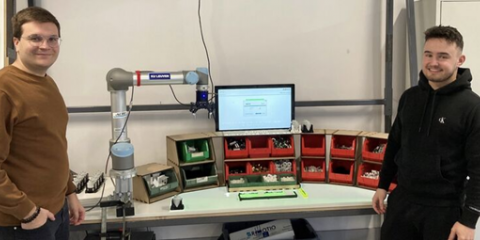Innovative assembly cell boosts self-confidence of workers

Master students Industrial Engineering Electromechanics, Jérémy Hendrickx and Kevin Houben, were commissioned by Bewel to work on an assembly cell in which custom workers learn to individually assemble a sixteen-piece product using the Arkite Operator Guidance Platform and a collaborative robot (UR5). Being able to perform - instead of one specific one - all assembly tasks really boosts the custom workers' self-confidence.
"With the help of technology, we want to increase the knowledge and ability of our employees, let them perform more complex tasks and reduce the burden of errors." says Benny Claes, Innovation and Technology engineer at Bewel. Therefore, as part of the CEROS-Coock project, Bewel went knocking on the doors of the 'neighbours' of FlandersMake@KULeuven's ACRO research group on the Diepenbeek campus. Together they submitted a master's thesis to the Industrial Engineering programme: 'Development and validation of an inclusive assembly cell to train and monitor workers'.
Human aspect as added value
Master's students Jérémy Hendrickx and Kevin Houben both chose this assignment very deliberately. For them, the added value lays in the human aspect of this master's thesis. "Just the fact that we could eventually also work with the people for the tests made it so interesting. In a pure research setting, I would not have chosen this master's thesis." said Kevin.
Work and training cell for assembly
In addition to the human aspect, there was of course the technological challenge. Under the guidance of PhD researcher Martijn Cramer, the students developed and implemented a work and training cell within Bewel that allows the workers to assemble a sixteen-piece product using the Operator Guidance Platform and a collaborative robot. This Arkite developed platform assists operators with assembly procedures through light projections and digital work instructions. The collaborative robot (UR5) supports the customiser during the assembly process by indicating parts and/or performing assembly steps independently.
Happy with the results
"We are extremely satisfied with the results achieved by the students and researchers. Validation tests showed that the Arkite 'Operator Guidance Platform' offers great added value for the group of workers who cannot perform the assembly actions independently without this assistive technology" said Benny Claes.
Eline Bijloos, the training coordinator within Bewel is also delighted with the learning curves achieved. "We see a demonstrable improvement in performance and this in a short period of time. And this new technology was also very well received by our workers themselves. The plan is therefore to integrate this elaborated work cell into the training programme of our custom workers."
Prof Karel Kellens, supervisor of the master's thesis, summarised the result as, "A great example where integration of research and innovative technologies together answer concrete industrial and societal needs."